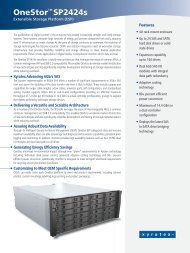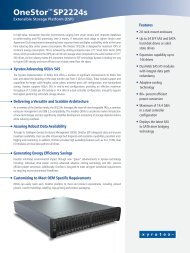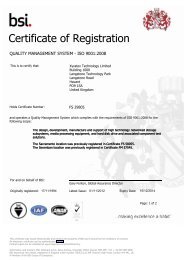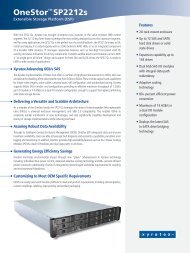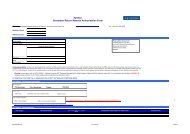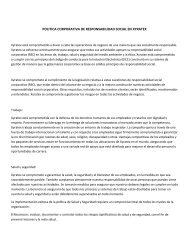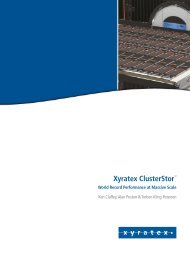compete. Identifiable intangible assets are amortized over time, while in-process research anddevelopment is recorded as a charge on the date of acquisition and goodwill is capitalized, subject toperiodic review for impairment. Accordingly, the allocation of the acquisition cost to identifiableintangible assets has a significant impact on our future operating results. The allocation processrequires extensive use of estimates and assumptions, including estimates of future cash flows expectedto be generated by the acquired assets. Should conditions be different than management’s currentassessment, material write-downs of the fair value of intangible assets may be required. We periodicallyreview the estimated remaining useful lives of our other intangible assets. A reduction in the estimateof remaining useful life could result in accelerated amortization expense or a write-down in futureperiods. As such, any future write-downs of these assets would adversely affect our operating results.We evaluate the impairment of goodwill on an annual basis, or sooner if events or changes incircumstances indicate that the carrying amount of an asset may not be recoverable. Triggering eventsfor impairment reviews may be indicators such as adverse industry or economic trends, restructuringactions or lower projections of profitability. Evaluations of possible impairment and, if applicable,adjustments to carrying values, require us to estimate, among other factors, future cash flows, usefullives, and fair market values of our reporting units and assets. Actual results may vary from ourexpectations. Accordingly, goodwill recorded in business combinations may significantly affect ourfuture operating results to the extent impaired, but the magnitude and timing of any such impairmentis uncertain. When we conduct our annual evaluation of goodwill the fair value of goodwill isre-assessed using valuation techniques that require significant management judgment. Should conditionsbe different than management’s last assessment, significant write-downs of goodwill may be required.Intangible assets as of November 30, 2005 were $50.9 million, and any future write-downs ofgoodwill would adversely affect our operating margin.Recent Accounting PronouncementsIn November 2004, the Financial Accounting Standards Board (FASB) issued Statement ofFinancial Accounting Standards No. 151, ‘‘Inventory Costs’’ (FAS 151). FAS 151 amends the guidance inAccounting Research Bulletin No. 43, Chapter 4, ‘‘Inventory Pricing’’, to clarify that abnormal amountsof idle facility expense, freight, handling costs and wasted materials (spoilage) should be recognized ascurrent-period charges and requires the allocation of fixed production overheads to inventory based onnormal capacity of the production facilities. This statement is effective for inventory costs incurredduring fiscal years beginning after June 15, 2005. The adoption of FAS 151 is not expected to have animpact on our financial position, results of operations or cash flows.In December 2004, the FASB issued FAS 123 (revised 2004), ‘‘Share-Based Payment’’ (FAS 123R)which will be effective in our 2006 fiscal year and will require that we use the fair value method tocalculate the expense related to our employee share based awards. We currently use the intrinsic valuemethod to measure compensation expense for share-based awards to our employees. Included inNote 2 to the consolidated financial statements is the pro forma net income and earnings per share asif we had used a fair-value-based method similar to the methods required under SFAS 123R tomeasure the compensation expense for employee share awards during our 2005, 2004 and 2003 fiscalyears.In March 2005, the SEC issued Staff Accounting Bulletin (‘‘SAB’’) 107, which offers guidance onFAS 123R. SAB 107 was issued to assist preparers by simplifying some of the implementationchallenges of FAS 123R while enhancing the information that investors receive. SAB 107 creates aframework that is premised on two overarching themes: (a) considerable judgment will be required bypreparers to successfully implement FAS 123R, specifically when valuing employee stock options; and(b) reasonable individuals, acting in good faith, may conclude differently on the fair value of employeestock options. Key topics covered by SAB 107 include valuation models, expected volatility and60
expected term. In October 2005, the FASB issued FSP FAS 123(R)-2, ‘‘Practical Accommodation to theApplication of Grant Date as Defined in FAS 123(R)’’. In November 2005, the FASB issued FSPFAS 123(R)-3, ‘‘Transition Election Related to Accounting for the Tax Effects of Share-Based PaymentAwards’’. These interpretations provide further guidance on the implementation of FAS 123R as set outin their respective titles. We will apply the principles of SAB 107 and these interpretations inconjunction with our adoption of FAS 123R.In March 2005, the FASB issued Interpretation No. 47, ‘‘Accounting for Conditional AssetRetirement Obligations’’ (‘‘FIN 47’’), which states that a company must recognize a liability for the fairvalue of a legal obligation to perform asset retirement activities that are conditional on a future eventif the amount can be reasonably estimated. FIN 47 clarifies that conditional obligations meet thedefinition of an asset retirement obligation in FAS No. 143, ‘‘Accounting for Asset RetirementObligations’’, and therefore should be recognized if their fair value is reasonably estimable. FIN 47 iseffective no later than the end of the first fiscal year ending after December 15, 2005, and will beadopted by us beginning December 1, 2005. We do not expect the adoption of this interpretation tohave a material effect on our financial condition or results of operationsIn May 2005, the FASB issued FAS No. 154, ‘‘Accounting Changes and Error Corrections’’(‘‘FAS 154’’), which replaced APB No. 20, ‘‘Accounting Changes’’ and FAS No. 3, ‘‘<strong>Report</strong>ingAccounting Changes in Interim Financial Statements’’. FAS 154 changes the requirements for theaccounting for and reporting of a change in accounting principle by requiring voluntary changes inaccounting principles to be reported using retrospective application, unless impractical to do so.FAS 154 is effective for accounting changes and corrections of errors made in fiscal years beginningafter December 15, 2005.In June 2005, the Emerging Issues Task Force (EITF) reached consensus on Issue No. 05-6,‘‘Determining the Amortization Period for Leasehold Improvements’’ (‘‘EITF 05-6.’’). EITF 05-6 providesguidance on determining the amortization period for leasehold improvements acquired in a businesscombination or acquired subsequent to lease inception. The guidance in EITF 05-6 will be appliedprospectively and is effective for periods beginning after June 29, 2005. Adoption of this standard is notexpected to have a material impact on our financial position or results of operations.In June 2005, the FASB issued Staff Position FAS 143-1, ‘‘Accounting for Electronic EquipmentWaste Obligations’’ (‘‘FSP 143-1’’), which provides guidance on the accounting for certain obligationsassociated with the Waste Electrical and Electronic Equipment Directive (the ‘‘Directive’’), adopted bythe European Union (‘‘EU’’). Under the Directive, the waste management obligation for historicalequipment remains with the commercial user until the customer replaces the equipment. FSP 143-1 isrequired to be applied to the later of the first reporting period ending after June 8, 2005 or the date ofthe Directive’s adoption into law by the applicable EU member countries in which the manufacturershave significant operations. Adoption of this standard is not expected to have a material impact on ourfinancial position or results of operations.In September 2005, the FASB issued EITF Issue No. 04-13, ‘‘Accounting for Purchases and Salesof Inventory with the Same Counterparty’’ (‘‘EITF 04-13’’). The issue provided guidance on thecircumstances under which two or more inventory transactions with the same counterparty should beviewed as a single nonmonetary transaction within the scope of APB Opinion No. 29, ‘‘Accounting forNonmonetary Transactions.’’ The issue also provided guidance on circumstances under whichnonmonetary exchanges of inventory within the same line of business should be recognized at fairvalue. EITF 04-13 will be effective for transactions completed in reporting periods beginning afterMarch 15, 2006. We are evaluating the impact that this will have on our consolidated financialstatements.61
- Page 3:
XYRATEX LTDANNUAL REPORT FOR THE YE
- Page 6 and 7:
INTRODUCTIONWe are incorporated und
- Page 8 and 9:
Year Ended November 30,2005 2004 20
- Page 10 and 11:
The computations for the weighted a
- Page 12 and 13:
The markets in which we operate are
- Page 14 and 15: technological capabilities. This co
- Page 16 and 17: may cease production of components,
- Page 18 and 19: • potentially adverse tax consequ
- Page 20 and 21: We could incur substantial costs, i
- Page 22 and 23: influence by voting at a meeting of
- Page 24 and 25: Xyratex Ltd to the former sharehold
- Page 26 and 27: In addition to the rapid growth of
- Page 28 and 29: RAID controller technology is proje
- Page 30 and 31: Our Competitive StrengthsDisk drive
- Page 32 and 33: the storage subsystem and disk driv
- Page 34 and 35: Our storage subsystems are internal
- Page 36 and 37: systems are capable of testing a fu
- Page 38 and 39: Research and DevelopmentWe have ove
- Page 40 and 41: • sets forth procedures for the p
- Page 42 and 43: Item 4C: Organization StructureXyra
- Page 44 and 45: ecame the parent company of our bus
- Page 46 and 47: Foreign Exchange Rate FluctuationsT
- Page 48 and 49: we recorded in the year ended Novem
- Page 50 and 51: Fiscal Year Ended November 30, 2005
- Page 52 and 53: Research and Development—otherThe
- Page 54 and 55: Fiscal Year Ended November 30, 2004
- Page 56 and 57: Selling, General and Administrative
- Page 58 and 59: Quarterly Results of OperationsThe
- Page 60 and 61: sales growth. The increase in defer
- Page 62 and 63: choose to make or alliances we have
- Page 66 and 67: ITEM 6: DIRECTORS, SENIOR MANAGEMEN
- Page 68 and 69: Ernest Sampias has served as a dire
- Page 70 and 71: Audit CommitteeOur Audit Committee
- Page 72 and 73: Employee Benefit/Share Option Plans
- Page 74 and 75: The maximum amount that any partici
- Page 76 and 77: Restricted StockRestricted stock aw
- Page 78 and 79: the options, warrants or rights, bu
- Page 80 and 81: Quarterly high and low market price
- Page 82 and 83: whose functional currency is not th
- Page 84 and 85: on the Nasdaq National Market and,
- Page 86 and 87: Interest RatesWe had cash and cash
- Page 88 and 89: aggregate in any fiscal year and th
- Page 90 and 91: (This page has been left blank inte
- Page 92 and 93: XYRATEX LTDAUDITED CONSOLIDATED BAL
- Page 94 and 95: F-4XYRATEX LTDAUDITED CONSOLIDATED
- Page 96 and 97: XYRATEX LTDNOTES TO AUDITED CONSOLI
- Page 98 and 99: XYRATEX LTDNOTES TO AUDITED CONSOLI
- Page 100 and 101: XYRATEX LTDNOTES TO AUDITED CONSOLI
- Page 102 and 103: XYRATEX LTDNOTES TO AUDITED CONSOLI
- Page 104 and 105: XYRATEX LTDNOTES TO AUDITED CONSOLI
- Page 106 and 107: XYRATEX LTDNOTES TO AUDITED CONSOLI
- Page 108 and 109: XYRATEX LTDNOTES TO AUDITED CONSOLI
- Page 110 and 111: XYRATEX LTDNOTES TO AUDITED CONSOLI
- Page 112 and 113: XYRATEX LTDNOTES TO AUDITED CONSOLI
- Page 114 and 115:
XYRATEX LTDNOTES TO AUDITED CONSOLI
- Page 116 and 117:
XYRATEX LTDNOTES TO AUDITED CONSOLI
- Page 118 and 119:
XYRATEX LTDNOTES TO AUDITED CONSOLI
- Page 120 and 121:
XYRATEX LTDNOTES TO AUDITED CONSOLI
- Page 122 and 123:
XYRATEX LTDNOTES TO AUDITED CONSOLI
- Page 124 and 125:
XYRATEX LTDNOTES TO AUDITED CONSOLI
- Page 126 and 127:
XYRATEX LTDNOTES TO AUDITED CONSOLI
- Page 128 and 129:
XYRATEX LTDNOTES TO AUDITED CONSOLI
- Page 130:
(This page has been left blank inte



